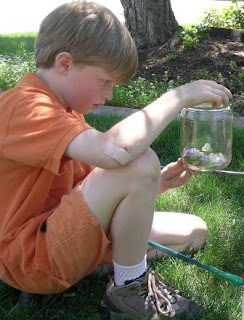 Since Nora can’t read yet, I think it’s safe to write about one of her Christmas presents. We bought her a Jack Skellington plush. She loves The Nightmare Before Christmas. It’s her favorite movie (and by favorite, I mean she’s so obsessed with it that she wakes up in the morning asking to watch it, and she carries the video case around the house with her and gives us a panicky “Where’s Jack?” when she’s misplaced it somewhere, and at night she throws a fit because we’ve only let her watch the movie twice instead of the 17 times she’s begged for it). Yes, it’s an odd choice for a two-year-old’s favorite movie, but we’re all a bit macabre around here.
Since Nora can’t read yet, I think it’s safe to write about one of her Christmas presents. We bought her a Jack Skellington plush. She loves The Nightmare Before Christmas. It’s her favorite movie (and by favorite, I mean she’s so obsessed with it that she wakes up in the morning asking to watch it, and she carries the video case around the house with her and gives us a panicky “Where’s Jack?” when she’s misplaced it somewhere, and at night she throws a fit because we’ve only let her watch the movie twice instead of the 17 times she’s begged for it). Yes, it’s an odd choice for a two-year-old’s favorite movie, but we’re all a bit macabre around here.Nora wants me to sing “Jack songs” to her at bedtime. This has proved difficult since the lyrics are extremely tricky and even now that I have finally looked them up, I’m not sure they make the most soothing lullabies:
I am the one hiding under your bedBut Nora loves Jack. And frankly I think it’s a great movie. We try to watch it every year between Halloween and Christmas. But only once.
Teeth ground sharp and eyes glowing red
I am the one hiding under your stairs
Fingers like snakes and spiders in my hair
My sister told me this week that her daughter Juniper also loves The Nightmare before Christmas, so now I’m wondering what it is about the movie that appeals to children. You’d think it would scare the bejeebers out of them. I’d like to suggest that we all have an innate taste for the macabre, for the images of death and gore. Cases in point: the inevitable rubbernecking at freeway wrecks, the popularity of horror movies, the fact that every time I turn on a news channel lately, I’m met with photographs of Caylee Anthony’s skeletal remains. But honestly, I suspect Nora has no clue what the movie’s really about. She certainly doesn’t have a clue about death. I think she just likes the music. And Jack.
Detail from Brueghel, Triumph of Death
 I’ve decided that The Nightmare Before Christmas is the modern equivalent of Pieter Brueghel’s Triumph of Death. You’ve got the dancing skeletons. The corpses. The morbid themes treated with a twisted sense of humor. It’s all there. I remember being fascinated by this painting in the Prado when I was a little girl. I also loved Bosch’s gruesome hell scene in his Garden of Earthly Delights. They were just plain cool. Of course, I had very little appreciation for the concept of death at the time. Now that I have children, I fear death in giant, parental proportions. But I also have such a respect for the reality of death that the painting amuses me more than scares me. I know that death is not likely to show up at my kitchen table with a lute in one hand, an hour glass in the other and an army of friends behind him. I also suspect that death doesn’t have a pinstriped tux, a bat-shaped bowtie and the voice of Danny Elfman.
I’ve decided that The Nightmare Before Christmas is the modern equivalent of Pieter Brueghel’s Triumph of Death. You’ve got the dancing skeletons. The corpses. The morbid themes treated with a twisted sense of humor. It’s all there. I remember being fascinated by this painting in the Prado when I was a little girl. I also loved Bosch’s gruesome hell scene in his Garden of Earthly Delights. They were just plain cool. Of course, I had very little appreciation for the concept of death at the time. Now that I have children, I fear death in giant, parental proportions. But I also have such a respect for the reality of death that the painting amuses me more than scares me. I know that death is not likely to show up at my kitchen table with a lute in one hand, an hour glass in the other and an army of friends behind him. I also suspect that death doesn’t have a pinstriped tux, a bat-shaped bowtie and the voice of Danny Elfman.So as Jack would say, “what the heck!” I can let Nora enjoy the movie despite its darkness because she sees only the light. I still think it’s better than the other syrupy, sparkly drivel out there marketed at preschool girls. And when requested, I will attempt to sing “Making Christmas” to my daughter without worrying about the fact that the melody comes from the Dies Irae, the medieval chant for the dead.


































